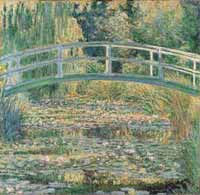Five paintings of summer subjects have been chosen for the month of August, the first being Claude Monet’s The Water-Lily Pond of 1899, which can be seen at the National Gallery. Monet was nearly sixty when he created this hypnotisingly beautiful work, one of the first of a long series of pictures inspired by the water garden which he had designed at his home in Giverny: a space of pure, fluctuant colour sensations.
Monet had moved to his house in Giverny, in rural Normandy, in 1883, and immediately set about transforming the land around the property. At the front of the house, he had inherited a typical Norman kitchen garden, planted with vegetables and fruit trees, which had provided generations of previous owners with fresh produce for much of the year. Monet arranged for the trees to be removed and the vegetables ploughed under. He redesigned the contours of the garden and planted his newly fertilised beds with a range of flowers – roses, dahlias, hollyhocks, nasturtiums as well as many more exotic blooms – carefully selected to ensure a vivid show of colour from early spring to the end of autumn. A few years later, a pond in a nearby meadow caught his eye. He bought the land and sought permission to develop it into a fashionably japoniste water garden, “for the pleasure of the eye,” as he wrote in his application, “and also for motifs to paint.”
It was an ambitious proposal, requiring ingenious engineering –a system of sluices to divert the necessary water from the nearby River Epte – an army of workmen and a mass of new plantings. Securing permission to proceed from Giverny town council was not straightforward. Local residents feared that the scheme might lessen the flow of the river and pollute its waters....


